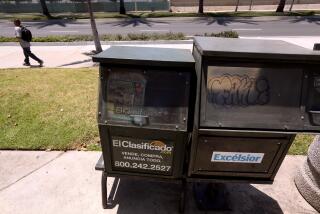Access for All : Computers: The Non Profit Network is bringing the information superhighway to youths and other people who can’t afford high-tech hardware.
- Share via
Westside residents Francisco Juarez and Candy Saenz see something fundamentally wrong with the information superhighway: Not everyone has access to an on-ramp.
So in February, 1993, Juarez and Saenz co-founded the Non Profit Network, a Santa Monica group seeking to bring the telecommunications revolution closer to high-tech have-nots, particularly those who live in largely low-income neighborhoods.
“Exposing them to more information is going to improve their quality of life,” said Juarez, a supervisor at GTE. “There’s a lot of talent that’s going to waste because of a lack of access.”
And equipping low-income areas with computers, Saenz and Juarez say, could promote the kind of communication that post-riot Los Angeles sorely needs. Said Saenz: “We felt that communication could be used to fill the gaps.”
Directed primarily at needy youngsters, the Non Profit Network has begun an ambitious slate of programs, including free computer classes at its Lincoln Boulevard headquarters, the Edward James Olmos Training Center. The organization’s 55 or so computer students range in age from 4 to 94.
In addition, Juarez conducts weekly classes on high-tech communications at the continuation campuses of Culver, Santa Monica, University and Venice high schools. Juarez outlines recent technological breakthroughs and explains such techno-phenomena as the information superhighway, fiber-optics and converging technology.
By the end of the year, the Non Profit Network will provide the four continuation schools with on-line computer access so that students from different schools can communicate with each other, hopefully reducing the risk of gang turf wars and destructive school rivalries.
“We’re trying to knock down the barriers by getting them to communicate,” said Saenz, a former gang member who says he turned his life around by joining the military during the Vietnam War. “Communication is the key to every solution.”
The stakes, he added, are high.
“Those are the kids that society has abandoned,” he said. “They need direction. If you don’t make it through the continuation school, the next step is the street.”
*
Network volunteers are also devising programs to help youngsters enter the telecommunications field. Eventually, they hope to open more computer centers in the city. As at the Olmos center, local residents could use the facilities to learn computer skills, access on-line information, send e-mail to elected officials and correspond with people from around the world.
“If we can’t bring it to their house, then we can bring it to their neighborhood,” Juarez said. “It will broaden their horizons, (showing) the world outside the barrio.”
An immediate goal is to expand the on-line network to other continuation schools in the city, Juarez said.
But the network’s financial resources have yet to catch up with its dreams. In the past year, corporate and private donations have trickled in. Thanks to recent donations of computer equipment from such local companies as Citizen Corp., Brentwood Computer and El Camino Management Co., the Non Profit Network has seven computers for training and enough others to bring the four continuation schools on-line.
Actor Edward James Olmos lent his name to the group’s Lincoln Boulevard computer training center in order to gain more visibility for the organization. And GTE donated a utility van. Six to eight volunteers, meanwhile, help fix the computers, run the office and conduct the training classes.
But the network will need more corporate and private donations in order to continue and expand its programs. Its main source of funding--a one-year $30,000 grant from the local chapter of the League of United Latin American Citizens, a Latino civil rights organization--will sustain the program until June.
Teachers and students express enthusiasm for the program, in part because it targets continuation students overlooked by many other programs.
Philip Kurman, law enforcement liaison officer and counselor at Olympic Continuation High School in the Santa Monica/Malibu school district, said Juarez gets students excited about learning.
“He’s been able to reach a lot of kids,” Kurman said. “He really wants them to succeed.”
Tom Yendes, a teacher at Olympic, credits the network with bringing people employed in telecommunications into the schools to show students what it takes to be successful and, at the same time, teach them a skill.
The students like the program “because they see an opportunity for jobs, advancement. And they see someone who cares about them,” Yendes said. “They can relate to the kids, and the kids can relate to them.”
The Non Profit Network is at 2208 Lincoln Blvd.; (310) 392 - 0444.






